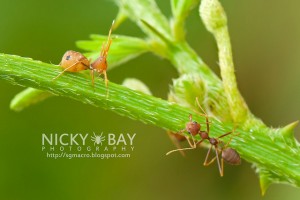I’m, mi-mi-mistaken…
The above title, in my opinion truly encapsulates the complexity of the animal kingdom in which the behaviour and the relationships between animals are not as simple. Through the mimicry of the weaver ants, it aims to express such complicated interrelationships between insects and highlights the uniqueness of survival.

At the very first glance, the above first picture portrayed what seemed like a mutated caterpillar with two heads and bear similarity towards the weaver ant. Eerie? However upon reading the recount that followed, it affirms that it is indeed a moth caterpillar, Homodes Bracteigutta in its form to mimicry the weaver ant, Oecophylla Smaragdina.
The above behaviour of mimicry is nothing foreign to the animal kingdom, and specifically to the mimicry of the weaver ants, these ants does pride in a number of followers. Possibly threatened to the weaver ants’ aggressiveness to bring down much larger prey than themselves by subduing in cooperative efforts, it takes no wonder that the purpose of mimicry by other insects such as the caterpillar is to seek refuge from their bold predators by looking like them.
However, in some unfortunate circumstances, weaver ants do fall prey to its “followers”. In this instance, it is the mimicry of the crab spider, Amyciaea Lineatipes. The spider is described to seemingly wave its two front legs to what seemingly resembles as an antennae in order to attract the weaver ant as depicted in the photo below.
As the weaver ants approached the mimic cry spider, fooled by its similar appearance, the spider attacked that ant.And this observation of behaviour is aligned by the research done by Leong & Rozario (2012), on the mimicry of weaver ants. Hence from this brief ethogram, it hints at the behaviour of the weaver ant that is aggressive. But at the same time, leading to its demise when other animals like the spider observed this behaviour and utilise them at the expense of the weaver ant.
Literature Cited:
Leong, T.M. & V. D.Rozario, 2012. Mimicry of the weaver ant, Oecophylla Smaragdina, by the moth caterpillar, Homodes Bracteigutta, the Crab Spider, Amyciaea Lineatipes and the jumping spider, Myrmarachne Plataleoides. Nature in Singapore,5:39-56.
Bay, N.,2012. Weaver Ant Mimicry.Macro Photography in Singapore, 19 February 2012. Hosted on SGMacro: http://sgmacro.blogspot.sg/2012/02/weaver-ant-mimicry.html (accessed 5 April 2013).
“Weaver Ant Mimicry,” by SGMacro. SGMacro, 19 February 2012. URL: http://sgmacro.blogspot.sg/2012/02/weaver-ant-mimicry.html (accessed 5 April 2013)
